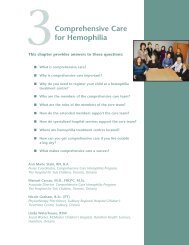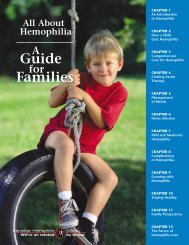Complications of Hemophilia
Complications of Hemophilia
Complications of Hemophilia
You also want an ePaper? Increase the reach of your titles
YUMPU automatically turns print PDFs into web optimized ePapers that Google loves.
8<strong>Complications</strong><br />
<strong>of</strong> <strong>Hemophilia</strong><br />
PART 2 - Joint and Muscle Damage<br />
■<br />
How will you know if your child has chronic<br />
synovitis<br />
Synovitis looks and feels different from an acute bleed. The joint<br />
looks “puffy” or swollen all the time. The swelling does not go<br />
away after a treatment <strong>of</strong> factor concentrate. If the joint has<br />
become permanently stretched from chronic swelling, it may not<br />
be painful. While a bleeding joint will quickly lose motion as<br />
blood fills the joint cavity, joints that are swollen from chronic<br />
synovitis usually continue to move without pain (that is, when<br />
they are not bleeding). However, they may lose motion over<br />
months or years.<br />
Table 1<br />
Differences between an acute bleed and synovitis<br />
Acute bleed Acute synovitis Chronic synovitis<br />
• Painful<br />
• Motion limited<br />
• Swelling may<br />
diminish with factor<br />
therapy<br />
• Joint may feel puffy<br />
• Joint may feel warm<br />
• Swelling unchanged<br />
with factor therapy<br />
• May not be painful<br />
• Motion maintained at<br />
first<br />
8-12<br />
All About<br />
<strong>Hemophilia</strong><br />
A<br />
Guide<br />
for<br />
Families
















